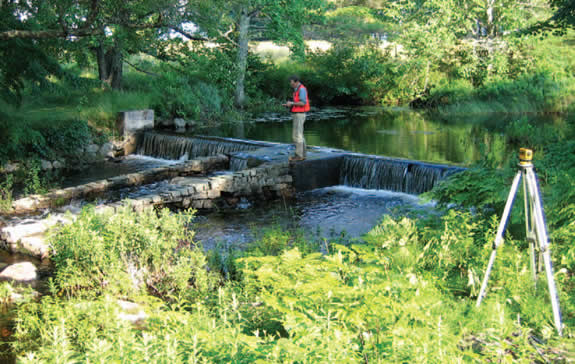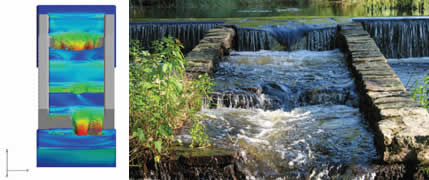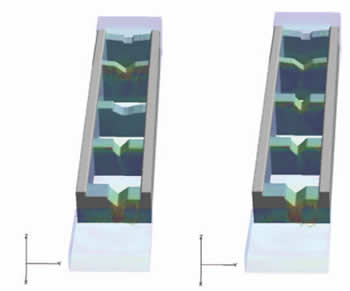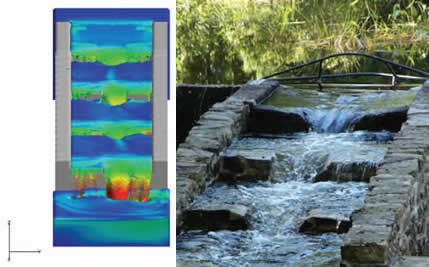July 2, 2007
By John E. Richardson
A fish ladder built 60 years ago on Mt. Desert Island in Maine to help alewife migrate to their freshwater spawning habitat had been deteriorating for years. Left in disrepair, it might have spelled doom for Alosa pseudoharengus had some engineers not been called in to make repairs.
 The damaged weirs at Third Dam on Somes Brook were surveyed prior to simulations. |
The crumbling Third Dam on Somes Brook in Somesville was preventing alewifes from making the springtime trip. To address this problem, the Somes-Meynell Wildlife Sanctuary called on Woodlot Alternatives, an environmental services firm in Topsham, Maine, to assess the problem and determine how the fish ladder could best be restored.
Under the leadership of Michael Chelminski, Woodlot’s ecological restoration director, the company performed a screening-level study of the flow over the five weirs in the fish ladder. Because analysis of this kind must assume that flow over weirs will conform to empirical relationships that are not necessarily accurate for a given situation, it was difficult to determine whether the proposed restoration would enable alewife to climb the ladder.
Recognizing this limitation, Woodlot asked Blue Hill Hydraulics of Blue Hill, Maine, to complete a 3D free-surface flow analysis to determine water surface elevations and velocities within the fish ladder to validate the proposed restoration design. Engineers used the FLOW-3D computational fluid dynamics (CFD) package from Flow Science, Inc. of Santa Fe, NM, to simulate flows. The analysis validated the renovation design and was used as part of the grant application for funding from the U.S. Fish and Wildlife Service Gulf of Maine Coastal Program.
Migratory Fish
The alewife is a diadromous fish, meaning it splits its lifecycle between marine and fresh-water ecosystems. Because it is one of the most common diadromous fishes in Maine, it is regarded as an important commercial and ecological resource.
 Fig 1: The deteriorated fish ladder: The image at left is the calculated flow configuration, while an actual photograph at right shows damaged lower weirs. |
Each spring, alewife migrate from the ocean upstream through rivers and streams to spawn in freshwater lakes and ponds. After hatching, young alewife spend two to six months in freshwater before migrating back to the sea. Alewife are important to the ecology of the freshwater, estuarine, and marine environments, and both adults and juveniles represent a food source for striped bass, brown trout, eels, salmon, osprey, cormorants, and other fish-eating mammals.
Since the early 1970s, more than $12 million of federal, state, and private utility funds have been spent on fish ladders to allow Atlantic alewife and other diadromous fish to return to their historical spawning areas. Fish ladders are typically placed on or around man-made barriers such as dams. Pool and weir “fish passes” enable fish to pass the barrier by swimming up through a series of relatively low steps. The velocity of the water falling over the steps has to be high enough to attract the fish to the ladder but cannot be so high as to wash the fish back downstream, or exhaust them.
The fish ladder at Third Dam is comprised of two lateral walls set perpendicular to the dam spillway with five internal weirs. The two upstream weirs and connecting lateral walls are constructed of concrete with the upstream-most weir set inline with the spillway. The invert of this weir is set below that of the spillway, and all flow passes through the upstream-most weir when water levels are below the spillway invert. The lateral walls of the upstream weirs are set approximately 0.15 feet above the spillway invert so they function as lateral weirs when overtopped, modulating flows that occur in the fish ladder during periods of high flow.
 Fig 2: Fish ladder designs here show the existing ladder (left) and the proposed fix (right). Graphics created with FLOW-3D output and Fieldview from Intelligent Light. |
One-Dimensional flow analysis
The U.S. Army Corps of Engineers Hydrologic Engineering Center River Analysis System (HEC-RAS) hydraulic modeling software was used to analyze 1D flow over the fish ladder under the assumption of hydrostatic conditions. The analysis completed with the HEC-RAS software included flow through the fish ladder and lateral overflow of the concrete walls between the upstream weirs.
A limitation of one-dimensional hydraulic analysis is that velocities are assumed to be the same across channel/river cross-sections. However, lateral velocities in a fish ladder vary considerably. These variations greatly contribute to the goal of enabling fish to climb them. For example, alewife swim at about 3 feet per second and are able to sense lower velocity zones. So, for a successful fish ladder, a key requirement involves the creation of contiguous pathways where water velocities do not exceed swim speeds.
Woodlot Alternatives hired Blue Hill Hydraulics to perform a 3D CFD simulation of flow through the proposed fish ladder. The results of these simulations provided accurate predictions of water surface elevation and velocity, making it possible for engineers to evaluate the performance of the fish ladder in detail.
Blue Hill Hydraulics elected to use the FLOW-3D CFD software system because of its unique ability to model free surface flows (e.g., flow through fish ladders and in rivers). FLOW-3D uses the volume of fluid (VOF) method to simulate free-surface fluid motion. The program includes special algorithms that maintain sharp liquid and gas interfaces, and it applies boundary conditions at solid surfaces and at free surfaces. This last feature is essential to modeling the dynamic flows associated with this project.
3D CFD simulation
Engineers at Blue Hill Hydraulics began by modeling flow through the deteriorated fish ladder using a CAD model created by Woodlot Alternatives. The CAD model was based on field survey information and exported in an STL format. These data were imported into FLOW-3D, the grid size specified, and then the 84,000 hexahedral computational mesh was automatically generated. Pressure boundary conditions were specified at the upstream end of the fish ladder and a downstream continuative boundary condition (i.e., free outflow) was applied.
The FLOW-3D model results matched observed fish ladder flows closely. As shown in Figure 1, the configuration of flow through the ladder appears to be quite similar to the actual flow configuration in the deteriorated fish ladder. In addition to this, results of the CFD model also provided detailed velocity information, making it possible to determine where changes to the fish ladder’s design should be made to improve the likelihood of the alewife’s migration.
 Fig 3:Renovated fish ladder: Left image shows the calculated flow, accompanied by a photograph of the repaired ladder showing confirmation of the flow simulation. |
Designing Fish Ladder Renovations
The next step was to develop a design for the renovated fish ladder (see Figure 2) and evaluate its performance over a range of flow conditions. Woodlot Alternatives provided an initial concept design based on the HEC-RAS and FLOW-3D modeling results. While there were no drawings of the original ladder, the engineers were able to surmise its approximate shape and then make additional modifications with the goal to slow flow through certain parts of the structure in order to provide an easily navigable passage for the fish. To facilitate these improvements, the middle weir was designed to maintain the asymmetrical shape of the two downstream masonry weirs and its elevation was increased to equalize the hydraulic drop between it and the upstream weirs. Blue Hill Hydraulics then updated the original CFD model to evaluate the planned changes.
The simulation results clearly showed how the proposed renovations would affect the flow of water in the fish ladder. The results predicted the distribution of flow, water surface elevations, and velocities in the ladder. Additional results showed velocities at different cross-sections so that water speed at various depths could be evaluated to determine the ability of fish to pass any given area of the fish ladder.
The revised CFD model showed that the proposed design would work as intended and renovations would allow alewife to negotiate the fish ladder. The revised model could also be used to simulate fish passage performance over a range of conditions. This is important because variations in river flows occur throughout the entire fish migration period — spring through fall for adults and juveniles — and we needed confirmation that these variations would not prevent fish passage up the ladder.
Renovations to the ladder were completed in September 2006. As shown in Figure 3, flow over the renovated ladder closely matched the CFD predictions.
Blue Hill Hydraulics
Blue Hill, ME
bluehillhydraulics.com
Woodlot Alternatives
Topsham, ME
woodlotalt.com
Flow Science Inc.
Santa Fe, NM
flow3d.com
John Richardson, Ph. D., is the president of Blue Hill Hydraulics, a scientific consulting company located in Blue Hill, Maine. The company specializes in the application of numerical modeling methods used to solve complex fluid flow problems and serves commercial clients, government agencies, and research organizations. Send comments about this article to [email protected].
Subscribe to our FREE magazine, FREE email newsletters or both!
About the Author
DE’s editors contribute news and new product announcements to Digital Engineering.
Press releases may be sent to them via [email protected].






